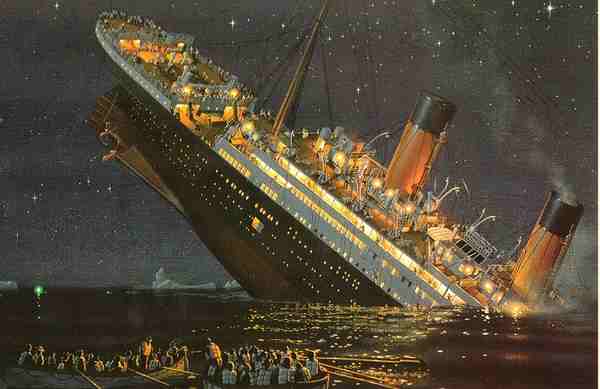Titanic Facts of Titanic History from its construction
The Titanic Facts of Titanic History show it to be perhaps the most tragic story known the world over.
The most celebrated ocean liner of its time even before it first sailed, the RMS Titanic was an incredible feat of engineering and ambition. Its maiden voyage ended in tragedy when it struck the now famous Titanic iceberg and sank, killing more than 1,500 passengers and crew.
Here is a brief Titanic Timeline from the construction of the ship in Belfast in northern Ireland to the attempts to raise the Titanic.

Titanic Facts of Titanic History:
The Titanic Construction
The Titanic Ship was one of three 'Olympic Class' liners commissioned by the White Star Line to be built at the Harland and Wolff shipyard in Belfast, northern Ireland. Construction began on the Olympic, on 16 December 1908.
Work on the Titanic ship started soon after, on 31 March 1909. These vessels were the industrial marvels of their age and the Titanic ship was to be the biggest, fastest and most luxurious liner yet.
After just three years, RMS Titanic was finished - a floating city, ready to set sail on her maiden voyage from Southampton to New York. On board was a collection of passengers on the RMS Titanic comprising millionaires, silent movie stars, school teachers and emigrants, in search of a better life in the United States.
Titanic Facts of Titanic History &
How did the Titanic Sink? When did the Titanic Sink?
By the fifth day of its journey, the history of the Titanic ship shows it was making swift progress across the Atlantic. Although Captain Edward Smith had plotted a new course upon hearing earlier reports of ice from other liners, there were many more communications that day of ice in Titanic ships path.
On the night of Sunday 14 April 1912, the sea was flat calm, the sky clear and moonless, and the temperature was dropping towards freezing. In such conditions, sea ice is very hard to spot.
At 11.40pm the lookout sounded the alarm and telephoned the bridge saying "Iceberg, right ahead." The warning came too late to avoid the Titanic iceberg and the Titanic ship struck it less than 40 seconds later, tearing a series of holes along the side of the hull.
Upon inspecting the damage, Titanic Ships chief naval architect Thomas Andrews said to Captain Smith that the ship would certainly sink. Six of the watertight compartments at the front of the ship's hull were breached, five of them flooding within the hour.
The Titanic ship was designed to stay afloat with only four compartments flooded.
Less than three hours later RMS Titanic shipwreck lay at the bottom of the Atlantic ocean, nearly four kilometres down. The sinking of Titanic claimed more than 1,500 lives and left the remaining Titanic survivors.
The history of the Titanic story has captured the public imagination across the world, spawning countless books, films, plays, memorials, museums and exhibitions. One of the most famous Titanic movies was the 1997 blockbuster starring Kate Winslet.
Titanic facts of Titanic History:
Titanic wreck
The discovery of the Titanic wreck by oceanographer Robert Ballard on a Franco-American expedition in 1985 gave rise to a fresh wave of interest in the history of Titanic that continues to this day.
The history of the Titanic showed that she was never seen again after that cold April night in 1912 until this discovery on September 1, 1985 by Dr. Robert Ballard of the Woods Hole Oceanographic Institute in Boston, Massachusetts. Previous expeditions in the early 1980's by Texas oilman Jack Grimm were unsuccessful in locating the Titanic wreck.
Dr. Ballard did initial research and photography of the Titanic wreck upon its 1985 discovery, and returned in the summer of 1986 conducting a manned expedition that included an exploration into the interior of the history of Titanic wreck.
Raising of Titanic
Upon the completion of that expedition, Dr. Ballard urged that the Titanic ship remain a memorial to those who had died in the disaster, and be left undisturbed. However, in 1987, Titanic Ventures, gained full salvage rights to the Titanic wreck .
Although highly controversial, several expeditions were carried out to raise artifacts from the Titanic, arguing that the Titanic is in a state of rapid decay, and raising the artifacts will secure her legacy for future generations.
Top to Titanic Facts of Titanic History
Home to Uniquely northern Ireland


